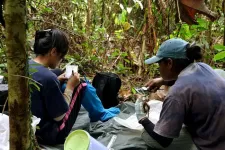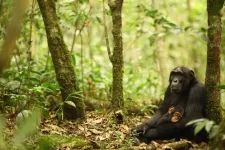(Press-News.org) For decades, catalysts have been unsung heroes in daily life. These workhorses transform a starting material into a product or fuel with lower energy, like the yeast in bread making and human-made catalysts for converting raw materials into fuels more efficiently and sustainably. A promising class of these helpful substances, called single atom catalysts, has emerged, and researchers need new methods to better understand them. More specifically, they want to know how the structure of the sites where chemical reactions occur, called active sites, affects the catalyst’s ability to speed up the chemical reaction rate, known as the activity.
In an important step forward, researchers from the Stanford Synchrotron Radiation Lightsource (SSRL) at the Department of Energy’s SLAC National Accelerator Laboratory collaborated with a team from the University of California, Davis (UC Davis), to develop a new software tool that can provide more quantitative details about the structure of the active sites in single atom catalysts in much less time, compared to current methods. The results were published in Chemistry–Methods.
Normally, a catalyst uses an inert support to stabilize nanometer-sized clusters of metal atoms, or metal nanoparticles. During catalysis, only the surface atoms act as active sites, leaving atoms in the interior of the nanoparticle unused. To maximize the utilization of each metal atom, researchers came up with a promising idea – single atom catalysts, where individual metal atoms are dispersed onto the support.
In designing and developing these catalysts, researchers need to understand the structure of the active sites so they can relate it to the activity. To learn more about the structure, the team used single platinum atoms stabilized on a magnesium oxide support as a case study for similar single atom catalysts. The study’s lead author Rachita Rana, who recently received her PhD from UC Davis, utilized a technique called extended X-ray absorption fine structure (EXAFS) spectroscopy, which reveals the average environment around the atom in the active site, such as the number and distance of neighboring atoms. Traditionally, with EXAFS data, researchers evaluate tens to hundreds of candidate structures before selecting the best fit. Instead, Rana proposed automating the analysis process by combining theoretical calculations, called density functional theory, and EXAFS. The first version of the software, QuantEXAFS, determined the structure for one kind of atom, platinum atoms in this case.
In reality, catalysts usually have both single atoms and nanoparticles. Building upon QuantEXAFS, Rana expanded the capabilities of the code to determine the fractions of these two forms, giving more specific information about the structure. “MS-QuantEXAFS not only helps identify the active sites, but also quantifies the percentage of a specific site and automates the entire data analysis process,” she said. “If you’re doing this manually, it typically could take you anywhere from a few days to months. With MS-QuantEXAFS, you could potentially do this analysis overnight on a local computer.”
The team would next like to prepare and release MS QuantEXAFS to the scientific community. “This tool has a lot to offer to catalysis researchers,” said Rana. Co-author and Distinguished Scientist at SSRL, Simon R. Bare, agrees, adding that they also plan to include it in training classes, especially for the next generation of students.
The DOE Office of Science supported this research. SSRL is a DOE Office of Science user facility.
END
Pioneering new tool will spur advances in catalysis
Catalysts do surprising things to assist with daily life - from bread making to turning raw materials into fuels more efficiently. SLAC researchers helped develop an automated analytical method to speed the discovery process in single atom catalysts
2025-01-09
ELSE PRESS RELEASES FROM THIS DATE:
Physical neglect as damaging to children’s social development as abuse
2025-01-09
CHAMPAIGN, Ill. — While physical neglect is understudied compared to physical, sexual or emotional abuse, neglect is just as damaging to children’s social development, a new study indicates.
More than 9,150 individuals, nearly 41% of whom retrospectively reported some form of maltreatment before age 12 or reaching the sixth grade, were included in the study, published in the journal Child Abuse and Neglect. The project explored the impact of abuse or neglect on three dimensions of children’s structural peer relationships — whether maltreated youth were less social/more withdrawn, less popular with or avoided by their peers and how ...
Earth scientist awarded National Medal of Science, highest honor US bestows on scientists
2025-01-09
UNIVERSITY PARK, Pa. — Richard Alley, Evan Pugh University Professor of Geosciences at Penn State, was awarded the National Medal of Science at a White House ceremony on Jan. 3.
Alley was one of 23 individuals and two organizations awarded the 2025 National Medals of Science and National Medals of Technology and Innovation, the nation’s highest honors for achievement and leadership in science and technology.
“Dr. Alley is deeply deserving of this most prestigious honor, and it is heartening to know that our nation sees in him what the Penn State community has known for decades,” said Penn State President Neeli Bendapudi. “Dr. ...
Research Spotlight: Lipid nanoparticle therapy developed to stop tumor growth and restore tumor suppression
2025-01-09
Yang Zhang, PhD, and Jinjun Shi, PhD, both of the Center for Nanomedicine and Department of Anesthesiology, Perioperative and Pain Medicine at Brigham and Women’s Hospital, are co-senior authors of a paper published in ACS Nanoscience Au, “Lipid Nanoparticle Delivery of mRNA and siRNA for Concurrent Restoration of Tumor Suppressor and Inhibition of Tumorigenic Driver in Prostate Cancer.”
How would you summarize your study for a lay audience?
Most cancers occur when there is an imbalance of cellular growth and inhibition, causing cells to grow rapidly and form tumors in the body. For example, ...
Don’t write off logged tropical forests – converting to oil palm plantations has even wider effects on ecosystems
2025-01-09
A research team led by the University of Oxford has carried out the most comprehensive assessment to date of how logging and conversion to oil palm plantations affect tropical forest ecosystems. The results demonstrate that logging and conversion have significantly different and cumulative environmental impacts. The results have been published today (10 January) in Science.
Understanding how different aspects of tropical forests are affected by logging and conversion to oil palm plantations is important for identifying priority habitats for conservation and restoration. It can also help aid decisions on land use – for instance, whether a logged forest should be ...
Chimpanzees are genetically adapted to local habitats and infections such as malaria
2025-01-09
Chimpanzees bear genetic adaptations that help them thrive in their different forest and savannah habitats, some of which may protect against malaria, according to a study by an international team led by UCL researchers.
Chimpanzees are our closest living relatives, sharing over 98% of their DNA with humans, and the scientists say that their findings, published in Science, can not only teach us about our own evolutionary history, but also about the biology of malaria infection in humans.
Chimpanzees are endangered ...
Changes to building materials could store carbon dioxide for decades
2025-01-09
Replacing conventional building materials with materials modified to store carbon dioxide could move the planet closer to net-zero greenhouse gas emissions, according to a new study by Elisabeth Van Roijen and colleagues. The researchers calculate that full replacement of conventional building materials with these CO2-sequestering alternatives could store as much as 16.6 ± 2.8 gigatons of CO2 each year – an equivalent to about 50% of the anthropogenic CO2 emissions in 2021. Removing carbon dioxide from the atmosphere, along with decreasing emissions, is important for slowing ...
EPA finalized rule on greenhouse gas emissions by power plants could reduce emissions with limited costs
2025-01-09
In this Policy Forum, John Bistline and colleagues analyze the potential impacts of the U.S. Environmental Protection Agency’s finalized power plant rules regarding greenhouse gas emissions. Using nine models of the U.S. electric sector and energy systems, the researchers found that the rules would speed up the reduction of emissions in the power sector. Under the rules, the levels of carbon dioxide emitted by the sector would be 61%-81% below 2005 levels by 2040. Under current policies, emission levels would be 51% to 83% below 2005 levels by 2040, ...
Kangaroos kept a broad diet through late Pleistocene climate changes
2025-01-09
Samuel Arman and colleagues’ close examination of tooth microwear among living and extinct kangaroo species suggests that most of the species living in Australia during the Late Pleistocene had a broad, generalist diet rather than being specialized grazers. This broad diet likely allowed them to survive the glacial-interglacial cycles that drove fluctuations in vegetation on the continent. The findings add more evidence to the idea that human hunting, rather than failure to adapt to climate changes, ...
Sex-specific neural circuits underlie shifting social preferences for male or female interaction among mice
2025-01-09
Male and female mice both prefer social interaction with female mice under normal conditions, but both switch to preferring males when their survival is threatened, according to a new study by Anqi Wei and colleagues. These preferences are mediated by different neuronal circuitry in male and female mice related to dopaminergic neurons in the brain’s ventral tegmental area, the researchers found. The findings offer a clearer picture of the underlying biology of socio-sexual preferences. These preferences are essential for successful reproduction, ...
The basis of voluntary movements: A groundbreaking study in ‘Science’ reveals the brain mechanisms controlling natural actions
2025-01-09
Eight years of work. A collaboration between the Laboratory of Neuroethology of Non-Human Primates of the Department of Medicine and Surgery of the University of Parma, led by Luca Bonini, and a team from the Biorobotics Institute of the Sant'Anna School of Pisa, coordinated by Alberto Mazzoni, principal investigator at the Computational Neuroengineering Lab, with the contribution of Silvestro Micera, professor in Bioingeneering. Support from three projects funded by the European Research Council (ERC) and as many Italian national projects, including MNESYS and BRIEF. These are just some of the elements of a groundbreaking study published in ...
LAST 30 PRESS RELEASES:
Making lighter work of calculating fluid and heat flow
Normalizing blood sugar can halve heart attack risk
Lowering blood sugar cuts heart attack risk in people with prediabetes
Study links genetic variants to risk of blinding eye disease in premature infants
Non-opioid ‘pain sponge’ therapy halts cartilage degeneration and relieves chronic pain
AI can pick up cultural values by mimicking how kids learn
China’s ecological redlines offer fast track to 30 x 30 global conservation goal
Invisible indoor threats: emerging household contaminants and their growing risks to human health
Adding antibody treatment to chemo boosts outcomes for children with rare cancer
Germline pathogenic variants among women without a history of breast cancer
Tanning beds triple melanoma risk, potentially causing broad DNA damage
Unique bond identified as key to viral infection speed
Indoor tanning makes youthful skin much older on a genetic level
Mouse model sheds new light on the causes and potential solutions to human GI problems linked to muscular dystrophy
The Journal of Nuclear Medicine ahead-of-print tip sheet: December 12, 2025
Smarter tools for peering into the microscopic world
Applications open for funding to conduct research in the Kinsey Institute archives
Global measure underestimates the severity of food insecurity
Child survivors of critical illness are missing out on timely follow up care
Risk-based vs annual breast cancer screening / the WISDOM randomized clinical trial
University of Toronto launches Electric Vehicle Innovation Ontario to accelerate advanced EV technologies and build Canada’s innovation advantage
Early relapse predicts poor outcomes in aggressive blood cancer
American College of Lifestyle Medicine applauds two CMS models aligned with lifestyle medicine practice and reimbursement
Clinical trial finds cannabis use not a barrier to quitting nicotine vaping
Supplemental nutrition assistance program policies and food insecurity
Switching immune cells to “night mode” could limit damage after a heart attack, study suggests
URI-based Global RIghts Project report spotlights continued troubling trends in worldwide inhumane treatment
Neutrophils are less aggressive at night, explaining why nighttime heart attacks cause less damage than daytime events
Menopausal hormone therapy may not pose breast cancer risk for women with BRCA mutations
Mobile health tool may improve quality of life for adolescent and young adult breast cancer survivors
[Press-News.org] Pioneering new tool will spur advances in catalysisCatalysts do surprising things to assist with daily life - from bread making to turning raw materials into fuels more efficiently. SLAC researchers helped develop an automated analytical method to speed the discovery process in single atom catalysts





